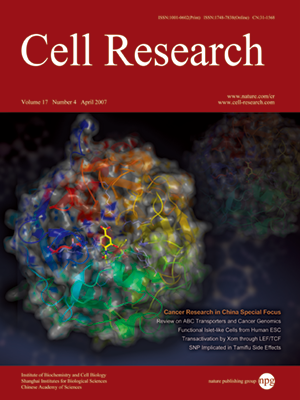
Volume 17, No 4, Apr 2007
ISSN: 1001-0602
EISSN: 1748-7838 2018
impact factor 17.848*
(Clarivate Analytics, 2019)
Volume 17 Issue 4, April 2007: 357-362
ORIGINAL ARTICLES
A nonsynonymous SNP in human cytosolic sialidase in a small Asian population results in reduced enzyme activity: potential link with severe adverse reactions to oseltamivir
Chuan-Yun Li1,*, Quan Yu2,*, Zhi-Qiang Ye1,*, Ying Sun1, Quanyuan He1,3, Xiao-Mo Li1, Wuxue Zhang1, Jingchu Luo1, Xiaocheng Gu1, Xiaofeng Zheng2 and Liping Wei1
1Center for Bioinformatics, National Laboratory of Protein Engineering and Plant Genetic Engineering, College of Life Sciences, Peking University, Beijing 100871, China
2Department of Biochemistry and Molecular Biology, National Laboratory of Protein Engineering and Plant Genetic Engineering, College of Life Sciences, Peking University, Beijing 100871, China
3Laboratory of Biochemistry, College of Life Sciences, Hunan Normal University, Changsha 410081, China
Correspondence: Liping Wei Xiaofeng Zheng(weilp@mail.cbi.pku.edu.cn xiaofengz@pku.edu.cn )
The use of oseltamivir, widely stockpiled as one of the drugs for use in a possible avian influenza pandemic, has been reported to be associated with neuropsychiatric disorders and severe skin reactions, primarily in Japan. Here we identified a nonsynonymous SNP (single nucleotide polymorphism) in dbSNP database, R41Q, near the enzymatic active site of human cytosolic sialidase, a homologue of virus neuraminidase that is the target of oseltamivir. This SNP occurred in 9.29% of Asian population and none of European and African American population. Our structural analyses and Ki measurements using in vitro sialidase assays indicated that this SNP could increase the unintended binding affinity of human sialidase to oseltamivir carboxylate, the active form of oseltamivir, thus reducing sialidase activity. In addition, this SNP itself results in an enzyme with an intrinsically lower sialidase activity, as shown by its increased Km and decreased Vmax values. Theoretically administration of oseltamivir to people with this SNP might further reduce their sialidase activity. We note the similarity between the reported neuropsychiatric side effects of oseltamivir and the known symptoms of human sialidase-related disorders. We propose that this Asian-enriched sialidase variation caused by the SNP, likely in homozygous form, may be associated with certain severe adverse reactions to oseltamivir.
Cell Research (2007) 17: 357-362. doi: 10.1038/cr.2007.27; published online 10 April 2007
FULL TEXT | PDF
Browse 1977


